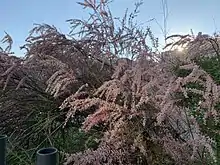Tamarix ramosissima
Tamarix ramosissima, commonly known as saltcedar[1] salt cedar, or tamarisk, is a deciduous arching shrub with reddish stems, feathery, pale green foliage, and characteristic small pink flowers.
| Tamarix ramosissima | |
|---|---|
 | |
| Scientific classification | |
| Kingdom: | Plantae |
| Clade: | Tracheophytes |
| Clade: | Angiosperms |
| Clade: | Eudicots |
| Order: | Caryophyllales |
| Family: | Tamaricaceae |
| Genus: | Tamarix |
| Species: | T. ramosissima |
| Binomial name | |
| Tamarix ramosissima | |
Description

Tamarix ramosissima is a hardy shrub or small tree native to Europe and Asia. It is a vigorous, deciduous shrub grown for its ornamental reddish stems, its showy plumes of flowers, and its unusual feathery leaves. Its hardiness and tolerance for poor soil make it a popular, easy to grow shrub. It can grow up to 8 m in height and up to 5 m in width. It can be used as a screen, windbreak, informal hedge or specimen shrub.[2]
It produces upright racemes of small, pink, five-petaled flowers from late summer to early autumn which cover the new wood of the plant. It is tolerant of many soil types, but prefers a well-drained, light or sandy soil in full sun. This plant is considered an invasive species in warmer climates.[2]
Invasive species
Tamarix ramosissima is a major invasive plant species in the Southwestern United States and Desert Region of California, consuming large amounts of groundwater in riparian and oases habitats.[2] The balance and strength of the native flora and fauna are being helped by various restoration projects, by removing tamarisk groves as if they were noxious weeds.[3]
Many assumptions of Tamarix ramosissima impact have been addressed by recent scientific investigations, which have generally concluded that the largest impact to Southwestern riparian ecosystems is the alteration of the flood regime by large dams.[4]
Salt
The plant's common name refers to its ability to tolerate salt water[5] by excreting salt into its leaves through specialized salt glands — thereby producing salt deposits which kill other species;[6] these salt deposits can also weaken interatomic binding in soil clays, leading to increased erosion.[5]
| Wikimedia Commons has media related to Tamarix ramosissima. |
References
- "saltcedar". Invasive Plant Atlas. Retrieved April 24, 2019.
- Zouhar, Kris. 2003. Tamarix spp. In: Fire Effects Information System, [Online]. U.S. Department of Agriculture, Forest Service, Rocky Mountain Research Station, Fire Sciences Laboratory.
- Afton Canyon Riparian Restoration Project Fourth Year Status Report. Archived 2015-12-06 at the Wayback Machine Bureau of Land Management. accessed 6/20/2010
- Wolf, E. 2016. Science driving a new management strategy for Tamarix
- Which came first, the salt or the saltcedar? A quantitative study of soil and groundwater chemistry along the Middle Rio Grande, New Mexico, by Michelle Cederborg, at the Colorado Riparian Association; published April 20, 2008; retrieved April 24, 2019
- Invasive Weeds - Salt Cedar, at the USDA Forest Service; retrieved April 24, 2019